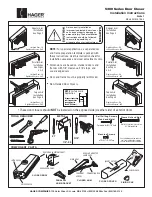
17
010.4150.0720 08.21
In such cases, the module can always be cleaned by:
• Circulating a cleaning liquid (CIP – Cleaning In Place).
• A solution of 5% phosphoric acid or 5% oxalic acid in
water is recommended to chemically clean the channels.
• The flow rate of the cleaning liquid should be greater
than the design liquid flow, and the flow should be in the
opposite direction through the heat exchanger relative to
the flow in normal operation.
ATTENTION: After cleaning, it is very important to flush the
heat exchanger thoroughly with clean water before start-up.
Cleaning gas side
Heavy condensation can have a self-cleaning effect, washing
the Cross and reducing dirt build-up on the gas side. The
module has open gas channels at both ends that can be
checked visually. For dry dirt such as carbon, ashes or
dust, most of the dirt sticks to the inlet surface. Cleaning
with compressed air or high-pressure water up to 200 bar
is normally effective. Exhausts from diesel, vegetable oils or
biogas combustion may require regular cleaning.
For greasy dirt such as oil, a suitable cleaning liquid is
recommended. When using cleaning liquid it is important to
flush the module thoroughly with clean water before start-up.
Storage
Some users store spare modules that are used to replace
dirty modules to reduce downtown.
The module must always be stored in a dry and protective
environment. The temperature should not be below 35°F
(1°C) and not above 120°F (50°C) for extended periods of
time (4 weeks or more).
During long operational stand-by periods, the system should
be inspected for contamination on the liquid and gas sides.
If necessary, clean the module according to the cleaning
instructions.
Liquid sides containing water should always be drained.








































